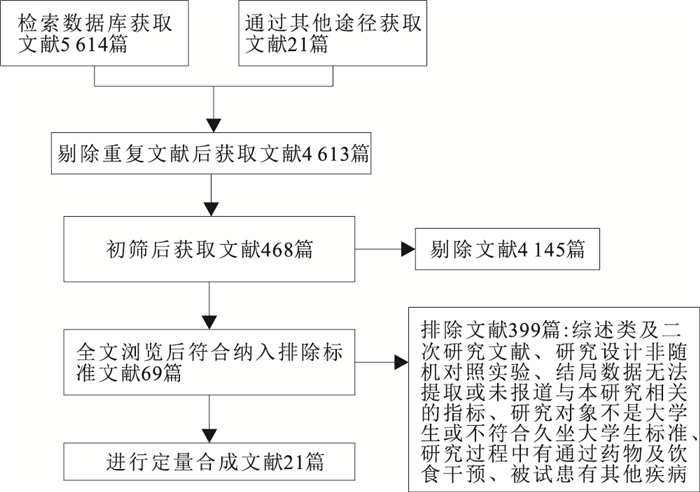Interval training for cardiopulmonary fitness of college students: a network Meta-analysis
-
摘要:
目的 比较不同类型间歇训练与持续训练对改善大学生心肺适能的效果,为大学生健康促进提供干预方法的证据支持。 方法 采用Meta分析的方法,检索Web of Science、PubMed、Science Direct、Scopus、the Cochrane Library和CNKI等数据库中建库至2020年4月1日关于传统高强度间歇训练(high-intensity interval training, HIIT)、重复冲刺训练(repeated-sprint training, RST)及短跑间歇训练(sprint-interval training, SIT)干预久坐不运动大学生的随机对照实验研究文献,由2名研究者独立对文献进行筛选、数据提取及偏倚风险的评估,采用Stata 16.0软件依次进行传统Meta分析及网状Meta分析。 结果 共纳入21篇文献728名样本;Meta分析显示HIIT(SMD=0.35,95%CI=0.10~0.60,P < 0.05), SIT(SMD=0.38,95%CI=0.05~0.70,P < 0.05)在提高VO2max指标上优于中等强度持续运动(moderate-intensity continuous training, MICT)、RST(SMD=-0.08,95%CI=-0.41~0.25,P>0.05)对比MICT差异无统计学意义;HIIT(SMD=0.40,95%CI=0.08~0.72,P < 0.05)、SIT(SMD=0.35,95%CI=0.03~0.67,P < 0.05)提高VO2max指标方面优于RST,HIIT与SIT(SMD=0.05,95%CI=-0.25~0.36,P>0.05)之间差异无统计学意义;4种训练方式提高VO2max指标的效果大小可能性排序为HIIT与SIT高于RST及MICT,且HIIT高于SIT,RST高于MICT。 结论 高强度间歇训练改善VO2max的效果整体优于MICT,且采用HIIT进行训练可能效果最好。 Abstract:Objective To compare the effects of different types of high-intensity interval training and moderate-intensity steady training on improving cardiorespiratory fitness of college students, and to provide evidence supporting intervention methods for health promotion of college students. Methods By using the method of Meta-analysis, Web of science, PubMed, Scopus and CNKI database was searched for randomized control trails regarding high-intensity intervention (HIIT), repeated-sprint training (RST) and sprint-interval training (SIT) among sedentary college students in April 1, 2020. Two independent researchers conducted literature filtering, data extraction, risk of bias assessment, as well as traditional Meta-analysis and network Meta-analysis by using Stata software version 16.0. Results A total of 21 articles and 728 participants were included. Meta-analysis showed that HIIT (SMD=0.35, 95%CI=0.10-0.60, P < 0.05) and SIT (SMD=0.38, 95%CI=0.05-0.70, P < 0.05) were significantly better than MICT, there was no statistical difference in RST (SMD=-0.08, 95%CI=-0.41-0.25, P>0.05) compared with MICT; HIIT (SMD=0.40, 95%CI=0.08-0.72, P < 0.05) and SIT (SMD=0.35, 95%CI=0.03-0.67, P < 0.05) were significantly better than RST, there was no significant difference between HIIT and SIT(SMD=0.05, 95%CI=-0.25-0.36, P>0.05). The ranking of the four training methods for improving the effect size of VO2max index was HIIT>SIT>RST>MICT. Conclusion The overall effect of high intensity interval training on VO2max is better than MICT, and HIIT training may be the best. -
Key words:
- Physical education and training /
- Growth and development /
- Oxygen consumption /
- Meta-analysis /
- Students
-
表 1 纳入文献的基本特征
Table 1. Basic characteristics of the included literature
第一作者及年份 国籍 年龄/岁 干预措施 运动形式 干预时间/周 实验组 对照组 Buchheit[10](2007) 挪威 24.6 跑步机 8 HIIT and RST MICT McKay[11](2009) 加拿大 25 功率自行车 8 HIIT MICT Sijie[12](2012) 中国 19~20 跑步 12 HIIT MICT 王京京[13](2015) 中国 20.8±1.1 跑台 12 HIIT MICT Zhang[14](2015) 中国 21±1 跑步机 12 HIIT MICT Kong[15](2016) 中国 19.9±2.1 功率自行车 5 RST MICT Kong[16](2016) 中国 21.5±4.0 跑步 5 RST MICT Elmer[17](2016) 美国 21.4±1.1 跑步 8 HIIT MICT 刘洪富[18](2016) 中国 - 功率自行车 12 HIIT MICT Nie[19](2018) 中国 21.0±1.1 功率自行车 12 HIIT MICT Sun[20](2019) 中国 21.4±1.1 功率自行车 12 HIIT and SIT MICT Trapp[21](2008) 澳大利亚 20.2±2 跑步 15 RST MICT Harris[22](2014) 英国 23.6±1.8 跑步 12 SIT RST Mazurek[23](2016) 波兰 20.9±0.94 功率自行车 8 RST MICT Obradovic[24](2016) 塞尔维亚 20.15±0.56 跑步机 4 SIT RST Marwa[25](2020) 法国 18.9±1 跑步 9 SIT MICT Sökmen[26](2018) 美国 24 跑步 10 SIT MICT Burgomaster[27](2008) 澳大利亚 23±1 跑步 6 SIT MICT Nalcakan[28](2014) 土耳其 21.7±2.2 功率自行车 7 SIT MICT Mazurek[29](2014) 波兰 19.5±0.6 功率自行车 8 RST MICT Matsuo[30](2014) 日本 26 跑步 8 HIIT and SIT MICT 注:HIIT为高强度间歇训练,RST为重复冲刺训练,SIT为短跑间歇训练,MICT为中等强度持续运动。 -
[1] 卢伯春, 於世海. 政策分析视野中的大学生体质健康危机[J]. 江苏高教, 2016(5): 134-136. https://www.cnki.com.cn/Article/CJFDTOTAL-JSGJ201605036.htmLU B C, YU S H. The health crisis of college students from the perspective of policy analysis[J]. Jiangsu High Educ, 2016(5): 134-136. https://www.cnki.com.cn/Article/CJFDTOTAL-JSGJ201605036.htm [2] 谢敏豪, 李红娟, 王正珍, 等. 心肺耐力: 体质健康的核心要素: 以美国有氧中心纵向研究为例[J]. 北京体育大学学报, 2011, 34(2): 1-7. https://www.cnki.com.cn/Article/CJFDTOTAL-BJTD201102002.htmXIE M H, LI H J, WANG Z Z et al. Cardiorespiratory fitness: a core component of health related physical fitness-introduction to the aerobics center longitudinal study[J]. J Beijing Sport Univer, 2011, 34(2): 1-7. https://www.cnki.com.cn/Article/CJFDTOTAL-BJTD201102002.htm [3] GIST N H, FEDEWA M V, DISHMAN R K, et al. Sprint interval training effects on aerobic capacity: a systematic review and meta-analysis[J]. Sports Med, 2014, 44(2): 269-279. doi: 10.1007/s40279-013-0115-0 [4] 沈文清, 孙景权, 严翊. 跑台训练对低心肺水平大学生心肺耐力的影响[J]. 中国学校卫生, 2017, 38(11): 1741-1743. doi: 10.16835/j.cnki.1000-9817.2017.11.042SHEN W Q, SUN J Q, YAN X. Effect of running platform training on cardiopulmonary endurance of college students with low cardiopulmonary level[J]. Chin J Sch Health, 2017, 38(11): 1741-1743. doi: 10.16835/j.cnki.1000-9817.2017.11.042 [5] HALLAL P C, ANDERSEN L B, BULL F C, et al. Global physical activity levels: surveillance progress, pitfalls, and prospects[J]. Lancet(London, England), 2012, 380(9838): 247-257. [6] 刘瑞东, 曹春梅, 刘建秀, 等. 高强度间歇训练的应用及其适应机制[J]. 体育科学, 2017, 37(7): 73-82. https://www.cnki.com.cn/Article/CJFDTOTAL-TYKX201707009.htmLIU R D, CAO C M, LIU J X et al. Application of high-intensity interval training and its adaption mechanism[J]. Chin Sci, 2017, 37(7): 73-82. https://www.cnki.com.cn/Article/CJFDTOTAL-TYKX201707009.htm [7] BUCHHEIT M, LAURSEN P B. High-intensity interval training, solutions to the programming puzzle[J]. Sports Med, 2013, 43(5): 313-338. doi: 10.1007/s40279-013-0029-x [8] ALESSANDRO L, ALTMAN D G, JENNIFER T, et al. The PRISMA statement for reporting systematic reviews and meta-analyses of studies that evaluate health care interventions: explanation and elaboration[J]. J Clin Epidemiol, 2009, 62(10): e1-34. doi: 10.1016/j.jclinepi.2009.06.006 [9] SHUSTER J J. Review: cochrane handbook for systematic reviews for interventions, version 5.1.0, published 3/2011. Julian P.T. Higgins and Sally Green, Editors[J]. Res Synth Meth, 2011, 2(2): 126-130. doi: 10.1002/jrsm.38 [10] BUCHHEIT M. The 30-15 intermittent fitness test: accuracy for individualizing interval training of young intermittent sport players[J]. J Strength Cond Res, 2008, 22(2): 365-374. doi: 10.1519/JSC.0b013e3181635b2e [11] MCKAY B R, PATERSON D H, KOWALCHUK J M. Effect of short-term high-intensity interval training vs. continuous training on O2 uptake kinetics, muscle deoxygenation, and exercise performance[J]. J Appl Physiol(1985), 2009, 107(1): 128-138. doi: 10.1152/japplphysiol.90828.2008 [12] SIJIE T, HAINAI Y, FENGYING Y, et al. High intensity interval exercise training in overweight young women[J]. J Sports Med Phys Fitness, 2012, 52(3): 233-262. http://europepmc.org/abstract/MED/22648463 [13] 王京京, 韩涵, 张海峰. 高强度间歇训练对青年肥胖女性腹部脂肪含量的影响[J]. 中国运动医学杂志, 2015, 34(1): 15-20. https://www.cnki.com.cn/Article/CJFDTOTAL-YDYX201501005.htmWANG J J, HAN H, ZHANG H F. Effects of high-intensity interval training and continuous training on abdominal fat in obese young women[J]. Chin J Sports Med, 2015, 34(1): 15-20. https://www.cnki.com.cn/Article/CJFDTOTAL-YDYX201501005.htm [14] ZHANG H, TONG T K, QIU W, et al. Effect of high-intensity interval training protocol on abdominal fat reduction in overweight chinese women: a randomized controlled trial[J]. Kinesiology, 2015, 47(1): 57-66. [15] KONG Z, SUN S, LIU M, et al. Short-term high-intensity interval training on body composition and blood glucose in overweight and obese young women[J]. J Diabetes Res, 2016, 2016: 1-9. DOI: 10.1155/2016/4073618. [16] KONG Z, FAN X, SUN S, et al. Comparison of high-intensity interval training and moderate-to-vigorous continuous training for cardiometabolic health and exercise enjoyment in obese young women: a randomized controlled trial[J]. PLoS One, 2016, 11(7): e158589. http://europepmc.org/articles/PMC4930190/ [17] ELMER D J, ELMER D J, LAIRD R H, et al. Inflammatory, lipid, and body composition responses to interval training or moderate aerobic training[J]. Euro J Appl Physiol, 2016, 116(3): 601-609. doi: 10.1007/s00421-015-3308-4 [18] 刘洪富, 刘忠民, 王常敏. 高强度间歇训练对肥胖青年女性减肥效果的研究[J]. 山东体育学院学报, 2016, 32(6): 95-98. https://www.cnki.com.cn/Article/CJFDTOTAL-TIRE201606017.htmLIU H F, LIU Z M, WANG C M. Effect of high intensity interval training on lose weight in obese young women[J]. J Shandong Sport Univer, 2016, 32(6): 95-98. https://www.cnki.com.cn/Article/CJFDTOTAL-TIRE201606017.htm [19] NIE J, ZHANG H, KONG Z, et al. Impact of high-intensity interval training and moderate-intensity continuous training on resting and postexercise cardiac troponin T concentration[J]. Exper Physiol, 2018, 103(3): 370-380. doi: 10.1113/EP086767 [20] SUN S, ZHANG H, KONG Z, et al. Twelve weeks of low volume sprint interval training improves cardio-metabolic health outcomes in overweight females[J]. J Sports Sci, 2019, 37(11): 1257-1264. doi: 10.1080/02640414.2018.1554615 [21] TRAPP E G, CHISHOLM D J, FREUND J, et al. The effects of high-intensity intermittent exercise training on fat loss and fasting insulin levels of young women[J]. Int J Obes, 2008, 32(4): 684-691. doi: 10.1038/sj.ijo.0803781 [22] HARRIS E, RAKOBOWCHUK M, BIRCH K M. Sprint interval and sprint continuous training increases circulating CD34+ cells and cardio-respiratory fitness in young healthy women[J]. PLoS One, 2014, 9(9): e108720. doi: 10.1371/journal.pone.0108720 [23] MAZUREK K, ZMIJEWSKI P, KRAWCZYK K, et al. High intensity interval and moderate continuous cycle training in a physical education programme improves health-related fitness in young females[J]. Biol Sport, 2016, 33(2): 139-144. doi: 10.5604/20831862.1198626 [24] OBRADOVIC J, VUKADINOVIC M, PANTOVIC M, et al. HⅡT vs moderate intensity endurance training: impact on aerobic parameters in young adult men[J]. Acta Kinesiol, 2016, 10(101): 35-40. [25] MARWA K, NEJMEDDINE O, MOHAMED S, et al. Continuous moderate-intensity but not high-intensity interval training improves immune function biomarkers in healthy young men[J]. J Strength Cond Res, 2020, 34(1): 249-256. doi: 10.1519/JSC.0000000000002737 [26] SÖKMEN B, WITCHEY R L, ADAMS G M, et al. Effects of sprint interval training with active recovery vs. endurance training on aerobic and anaerobic power, muscular strength, and sprint ability[J]. J Strength Cond Res, 2018, 32(3): 624-631. doi: 10.1519/JSC.0000000000002215 [27] BURGOMASTER K A, HOWARTH K R, PHILLIPS S M, et al. Similar metabolic adaptations during exercise after low volume sprint interval and traditional endurance training in humans[J]. J Physiol, 2008, 586(1): 151-160. doi: 10.1113/jphysiol.2007.142109 [28] NALCAKAN G R. The effects of sprint interval vs. continuous endurance training on physiological and metabolic adaptations in young healthy adults[J]. J Human Kinetics, 2014, 44(1): 97-109. doi: 10.2478/hukin-2014-0115 [29] MAZUREK K, KRAWCZYK K, ZMIJEWSKI P, et al. Effects of aerobic interval training versus continuous moderate exercise programme on aerobic and anaerobic capacity, somatic features and blood lipid profile in collegate females[J]. Ann Agric Environ Med, 2014, 21(4): 844-849. doi: 10.5604/12321966.1129949 [30] MATSUO T, SAOTOME K, SEINO S, et al. Effects of a low-volume aerobic-type interval exercise on VO2max and cardiac mass[J]. Med Sci Sports Exerc, 2014, 46(1): 42-50. doi: 10.1249/MSS.0b013e3182a38da8 [31] BLAIR S N. Physical inactivity: the biggest public health problem of the 21st century[J]. Br J Sports Med, 2009, 43(1): 1-2. [32] BUCHHEIT M, LAURSEN P B. High-intensity interval training, solutions to the programming puzzle[J]. Sports Med, 2013, 43(10): 927-954. doi: 10.1007/s40279-013-0066-5 [33] FOLLADOR L, ALVES R C, FERREIRA S D S, et al. Physiological, perceptual, and affective responses to six high-intensity interval training protocols[J]. Percept Motor Skills, 2018, 125(2): 329-350. doi: 10.1177/0031512518754584 [34] RODAS G, VENTURA J L, CADEFAU J A, et al. A short training programme for the rapid improvement of both aerobic and anaerobic metabolism[J]. Europ J Appl Physiol, 2000, 82(5-6): 480-486. doi: 10.1007/s004210000223 [35] HARMER A R, MCKENNA M J, SUTTON J R, et al. Skeletal muscle metabolic and ionic adaptations during intense exercise following sprint training in humans[J]. J Appl Physiol, 2000, 89(5): 1793-1803. doi: 10.1152/jappl.2000.89.5.1793 [36] HJULSTAD B F, FREDERIC S, MEGÂRD L I, et al. Comparison of three popular exercise modalities on VO2max in overweight and obese. [J]. Med Sci Sports Exer, 2016, 48(3): 491-498. doi: 10.1249/MSS.0000000000000777 [37] TORMA F, GOMBOS Z, JOKAI M, et al. High intensity interval training and molecular adaptive response of skeletal muscle[J]. Sports Med Health Sci, 2019, 1(1): 24-32. doi: 10.1016/j.smhs.2019.08.003 [38] WHYTE L J, GILL J M R, CATHCART A J. Effect of 2 weeks of sprint interval training on health-related outcomes in sedentary overweight/obese men[J]. Metabolism, 2010, 59(10): 1421-1428. doi: 10.1016/j.metabol.2010.01.002 [39] OZKAYA O, COLAKOGLU M, KUZUCU E O, et al. An elliptical trainer may render the wingate all-out test more anaerobic[J]. J Strength Cond Res, 2014, 28(3): 643-650. doi: 10.1519/JSC.0b013e3182a20f77 [40] BURGOMASTER K A, HUGHES S C, HEIGENHAUSER G, et al. Six sessions of sprint interval training increases muscle oxidative potential and cycle endurance capacity in humans[J]. J Appl Physiol, 2005, 98(6): 1985-1990. doi: 10.1152/japplphysiol.01095.2004 [41] BURGOMASTER K A, HEIGENHAUSER G J F, GIBALA M J. Effect of short-term sprint interval training on human skeletal muscle carbohydrate metabolism during exercise and time-trial performance[J]. J Applied Physiol, 2006, 100(6): 2041-2047. doi: 10.1152/japplphysiol.01220.2005 [42] SANDVEI M, JEPPESEN P B, STOEN L, et al. Sprint interval running increases insulin sensitivity in young healthy subjects[J]. Arch Physiol Bio, 2012, 118(3): 139-147. doi: 10.3109/13813455.2012.677454 [43] PAROLIN M L, CHESLEY A, MATSOS M P, et al. Regulation of skeletal muscle glycogen phosphorylase and PDH during maximal intermittent exercise[J]. Am J Physiol Endocrinol Metabolism, 1999, 277(5): e890-e900. doi: 10.1152/ajpendo.1999.277.5.E890 [44] CONSTANTINO COLEDAM D H, FERRAIOL P F, DOS-SANTOS J W, et al. Factors associated with cardiorespiratory fitness in school students[J]. Revist Brasil De Med Do Esport, 2016, 22(1): 21-26. doi: 10.1590/1517-869220162201123568 [45] EATHER N, RILEY N, MILLER A, et al. Efficacy and feasibility of HⅡT training for university students: the Uni-HⅡT RCT[J]. J Sci Med Sport, 2019, 22(5): 596-601. doi: 10.1016/j.jsams.2018.11.016 [46] NIC M, W K M, KRISTEN S, et al. Affective and enjoyment responses to high-intensity interval training in overweight-to-obese and insufficiently active adults[J]. J Sport Exercise Psychol, 2015, 37(2): 138-149. doi: 10.1123/jsep.2014-0212 -







 下载:
下载:




